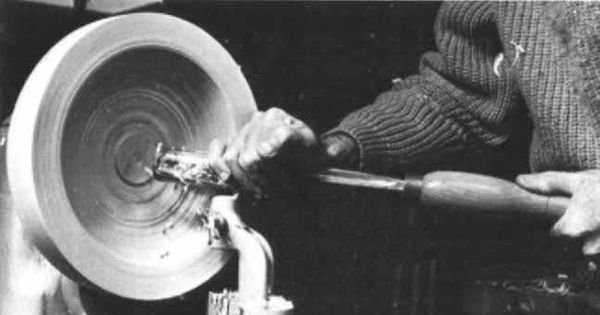
Synopsis: Peter Child jumps right into sharing tips on how to turn bowls, such as completing the turning of the outside of the bowl before removing any wood from the inside, to prevent problems with vibration. He lists problems awaiting amateurs and explains how to prevent those mistakes. His instructions include easy ways out that he doesn’t always recommend but that will help lead to increased confidence, along with proper stance and scraping and sanding advice. Detailed photos illustrate the step-by-step methods he discusses.
It is preferable to turn the outside of a bowl until it is ready to finish-sand before removing any wood from the inside. This should prevent troublesome vibration. Then, starting on the inside, there are three main problems facing the amateur:
- the outward thrust of the whirling wood on the gouge.
- starting a cut exactly where wanted without the risk of any sideways “kick,” which if not expertly controlled can ruin the work, especially at or near the rim of the bowl.
- two inside areas that have perforce to be cut against the grain and thus can tear out.
The long-and-strong bowl gouge at work on the outside of a bowl shears an arcing cut from hour hand 12 noon to 3 p.m. or to 9 a.m. depending on which way we are going. It should follow that the same action would be correct when taking out the waste from inside the bowl.
However, doing it this way actually invites a dig-in because whirling wood tends to throw the gouge blade over onto its back. The trailing edge and wing (the right-hand half of the blade) contact the wood and damage is inevitable. Without starting the lathe, place the gouge blade, bevel rubbing, at point A. Rotate the disc toward you slowly by hand and at the same time try to travel (bevel in contact but not cutting) from A to B. The wood surface pushes the blade back over to its right-hand edge, and the effect is more pronounced the nearer the blade gets to point B.
To start the cut correctly, set the rest below the center of the disc. With the gouge handle only slightly down from horizontal, the cutting edge can enter at A, the same height as the center of the bowl B. For small bowls—up to 7-in. diameter—entry near the outside rim is fine, and the cutting arc is slight. In large diameters, entry can be made anywhere along the straight line A to B. The gouge will enter quite easily an inch out from B, and successive cuts can be taken until point A is reached. However, the farther away from B, the more skittish the gouge will behave, and the more difficult it will be to start cutting exactly where wanted. In large bowls the arc of the cut ends before B is reached and the cut finishes in line with and across to B. Cutting from above and down to B can cause trouble.
From Fine Woodworking #7
For the full article, download the PDF below:
Fine Woodworking Recommended Products

CrushGrind Pepper Mill Mechanism

Shop Fox W1826

Forrest Woodworker II Blade




















Log in or create an account to post a comment.
Sign up Log in